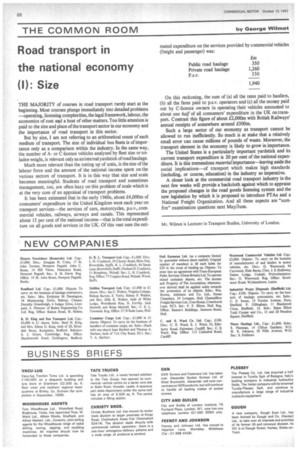THE COMMON ROOM
Page 90

If you've noticed an error in this article please click here to report it so we can fix it.
by George Wilmot
Road transport in the national economy (I): Size
THE MAJORITY of courses in road transport rarely start at the beginning. Most courses plunge inunediately into detailed problems —operating, licensing complexities, the legal framework, labour, the economics of cost ad a host of other matters. Too little attention is paid to the size and place of the transport sector in our economy and the importance of road transport in this sector.
But by size, I am not referring to an arithmetical count of each medium of transport. The size of individual bus fleets is of importance only as a comparison within the industry. In the same way, the number of Aor C-licence vehicles analysed by fleet size or unladen weight, is relevant only as an internal yardstick of road haulage.
Much more relevant than the totting up of units, is the size of the labour force and the amount of the national income spent on the various sectors of transport. It is in this way that size and scale becomes meaningful. Students of road transport and sometimes management, too, are often hazy on this problem of scale which is at the very core of an appraisal of transport problems.
It has been estimated that in the early 1960s, about £4,000m of consumers' expenditure in the United Kingdom went each year on transport services—the services of cars, motorcycles, p.s.v., commercial vehicles, railways, airways and canals. This represented about 15 per cent of the national income—that is the total expenditure on all goods and services in the UK. Of this vast sum the esti
mated expenditure on the services provided by commercial vehicles (freight and passenger) was: On this reckoning, the sum of (a) all the rates paid to hauliers, (b) all the fares paid to p.s.v. operators and (c) all the money paid out by C-licence owners in operating their vehicles amounted to about one half of all consumers' expenditure in the UK on transport. Contrast this figure of about £2,000m with British Railways' annual receipts of somewhere around £500m.
Such a large sector of our economy as transport cannot be allowed to run inefficiently. So much is at stake that a relatively small error can cause millions of pounds of waste. Moreover, the transport element in the economy is likely to grow in importance.
The United States is a particularly important yardstick and its current transport expenditure is 20 per cent of the national expenditure. It is this tremendous materia/importance—leaving aside the social implications—of transport which makes high standards (including, or course, education) in the industry so imperative.
A closer look at the commercial road transport industry in the next few weeks will provide a backcloth against which to appraise the proposed changes in the road goods licensing system and the new legislation by which it is proposed to introduce PTAs and a National Freight Organization. And all these aspects are "surefire" examination questions next May/June.


































































































































